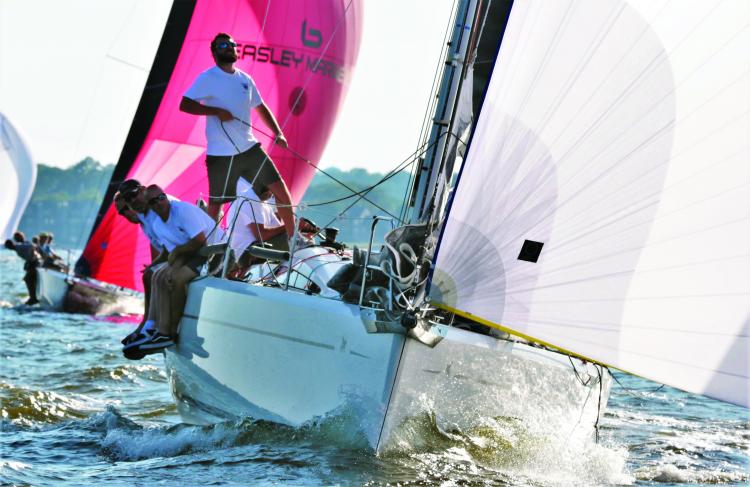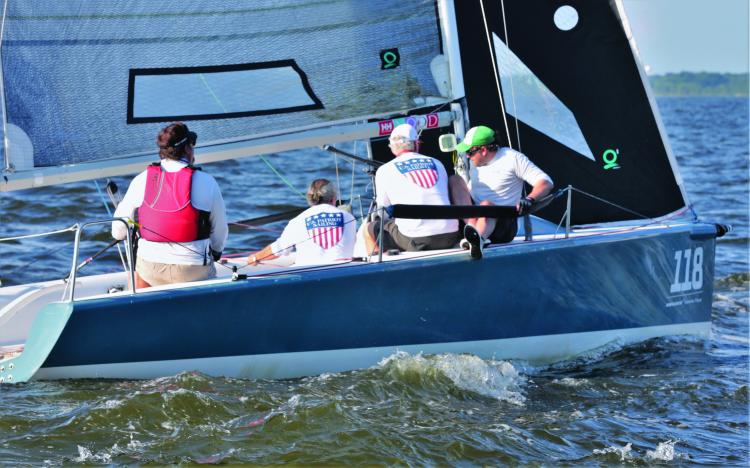The Tactician Gets the Credit… or Blame Onboard
Welcome to the hot seat. Inevitably in sailboat racing the tactician is the team member that gets the lion’s share of the credit or the blame. Do poorly and they are usually the first to get fired. In truth this is more than a little unfair since sailboat racing is very much a team sport. Anybody can be a great tactician if the boat is a little faster. It is a much easier job from the front row. Great crew mechanics are a big help as well and provide the tactician with a whole new set of options that a less accomplished team will just not have. Having been fortunate enough to sail with some of the best, I can tell you that there are some universal traits shared by top players.
Strategy vs. tactics
Though commonly lumped together, the first thing to understand is the distinction between strategy and tactics. Strategy is the big picture of how we get around the course fastest if there were no other boats based strictly on what the wind and current are going to do. Tactics is the boat-for-boat positioning that allows us to execute our strategy. It is the hand-to-hand combat of the game. On small boats these roles are one and the same.
On bigger boats there is often the luxury of having separate people for each role. The strategist paints the big picture. What the wind is doing. How much time to the starting line? Which side of the course appears favored? How much time to the lay line? How much time on port and starboard left in the leg? How much time to the mark? This information helps the tactician make better decisions about key questions. Should we tack or gybe here? Should we duck these starboard tackers and extend to the right or tack ahead of them? Should we tack immediately after the start? The critical trait found in top tacticians is that they don’t lose sight of the big picture. They don’t get so involved with boat-for-boat infighting that they lose the war.
Homework
Once out on the race course there are plenty of uncontrollable variables. Make sure you have the easy stuff covered. Be thoroughly familiar with the race instructions. Course options, starting sequence, recall procedure, and mark change options should be down cold. Monitor the weather and keep track of wind models so that you know what to look for on race day. If the actual conditions match the predicted ones, it will give you a much higher level of confidence in your strategy. Know what the current is supposed to be doing. Get the crew together on the way out to the race track and go over all this information. Give them the highlights of the instructions, expected courses, what you are looking for the wind to do and more. This will help with getting the boat set up in terms of sails, rig tune, and rigging.
The critical hour
There is a maxim in the literature of sailboat racing that has been around forever: Get to the race course at least one hour in advance. A lot goes on in this hour. You work on setting the boat up from a speed perspective. You do some tacks, at least one set, gybes, and a race takedown. For the tactician this is a time where you gather the information you need to make strategic decisions.
There is an old engineering saying: “In God we trust. All others bring data.” Tactics is simple if you know what the wind is going to do. There is a formula for managing persistent shifts versus oscillating wind patterns and for a combination of the two. If I know that the breeze is going right for the whole hour we sail prior to the start, my strategy is simple. I am going right on the first beat.
Keep track of port and starboard compass headings and true wind direction (if you have the instrumentation and good calibration) so that you have a baseline of what the wind is doing. After the start you will know whether you are headed or lifted relative to what the wind was before the start. Check the current on pots and buoys to see if it makes sense with the predicted current. Finally, get to the starting area in plenty of time to check the line. At a minimum you can get a compass heading to compare to true wind direction. A wind shot in the middle of the line is old school, but still works.
On more high-tech programs you will “ping” both ends of the start line and let GPS and software help you with the distance to the line. Ultimately, your starting plan depends on knowing if there is a favored (upwind) end of the line and balancing that off against where you want to go. Without all this critical information you will just be wandering around aimlessly.
Communicate
The best tacticians keep the team in the know. Painting the picture of what the game plan is helps everyone anticipate and do their jobs better. A quick synopsis: “Boat is slightly favored, so looking for a start in the boat third. Want to go straight and not have to tack early. Left has less current against us, and there may be left shift as we get closer to the shore.” The game plan may go out the window in the heat of battle as things change, but start with a plan.
Likewise, the team needs a heads up as tactical situations develop. “Close crossing with three starboard tackers coming up. Want to go farther right, so we will duck if it is close.” This alerts the trimmers that they should be ready to ease and lets the driver know what is coming so there are no surprises. As you approach a mark the team needs to know the plan for the next leg. “The breeze has gone right. Lots more port than starboard on the run. We will need an early gybe.” The ability to think ahead and communicate what is coming to the team is another trait shared by all the best.
Risk vs. reward
Ultimately the job of the tactician is to balance risk versus reward. You may be dead certain that the right side of the beat is favored, but if the bulk of the fleet is going left, you don’t have to do anything but stay to the right of the group. This is particularly true early in the race before it becomes clear what is working and what is not. On the second beat things should be a lot more clear, and the herd will be more obedient. If you get behind (this does happen even to the best), don’t panic and start banging the corners. Stay patient. The back of the fleet is usually a little easier to get through. Just pick them off one at a time. It is salvaging a 10th instead of a 28th that will win the regatta in the long run. Of course, this is all much easier if you are fast. Keep reminding your crew. Speed kills! Make me look good.
~By David Flynn of Quantum Sails






